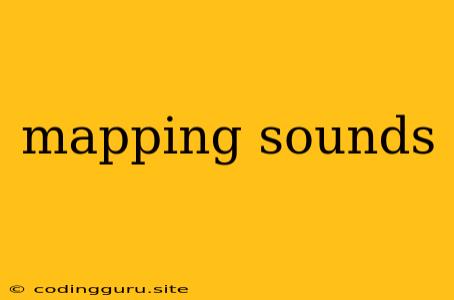Mapping Sounds: A Journey into Sonic Landscapes
Sound mapping is a fascinating and intricate field that explores the relationship between sound and its environment. It's about creating a detailed representation of how sound behaves in a particular space, capturing its unique character and nuances. This practice is increasingly relevant in various fields, from urban planning and environmental design to music composition and sound design.
Why is Sound Mapping Important?
Think about your favorite park or a bustling city street. Each location possesses a distinct sonic signature. Sound mapping helps us understand and analyze these soundscapes by capturing the following elements:
- Sound Sources: Identifying the origins of different sounds, like traffic, birdsong, or human voices.
- Sound Levels: Measuring the intensity and volume of different sounds, providing insight into potential noise pollution.
- Sound Propagation: Understanding how sound travels through the space, considering factors like obstacles, reflections, and absorption.
- Sound Quality: Evaluating the overall perceived quality of the soundscape, including factors like clarity, reverberation, and richness.
Techniques for Sound Mapping
There are various methods for capturing sound and creating sound maps:
- Acoustic Measurement Devices: Sophisticated equipment like sound level meters and spectrometers help quantify sound levels, frequency ranges, and other parameters.
- Field Recordings: Using portable recording devices like microphones and recorders to capture the soundscape directly.
- Software Analysis: Specialized software tools analyze captured sound data, creating visualizations and maps of sound distribution, propagation, and intensity.
Applications of Sound Mapping
Sound mapping has a wide range of practical applications across various fields:
- Urban Planning: Understanding noise pollution levels, identifying areas requiring noise mitigation strategies, and optimizing urban acoustic environments.
- Environmental Design: Designing spaces that minimize noise pollution and create comfortable, pleasant sound environments.
- Music Composition: Creating immersive and realistic soundtracks for films, games, and other media, based on real-world sound landscapes.
- Sound Design: Designing sound effects and atmospheres for games, film, and other media, using real-world sound recordings as inspiration.
- Accessibility: Understanding the impact of sound on people with hearing impairments and designing spaces and experiences that are inclusive and accessible.
Tips for Creating Sound Maps
If you're interested in creating sound maps, here are some tips to get started:
- Choose your location carefully: Select an area that has a unique or interesting soundscape.
- Plan your recording session: Determine the specific sounds you want to capture and the best recording techniques for your location.
- Use quality recording equipment: Investing in a good microphone and recorder will ensure high-quality sound recordings.
- Pay attention to detail: Capture sounds from different angles and distances to get a comprehensive understanding of the soundscape.
- Document your findings: Create clear and concise maps and visualizations of your findings, including sound sources, levels, and other relevant information.
Examples of Sound Mapping Projects
Several notable projects showcase the potential of sound mapping:
- Soundwalk project: This initiative uses sound walks to engage communities in understanding and appreciating their local soundscapes.
- The Noise Pollution Map: This online platform provides interactive maps of global noise pollution levels, raising awareness about this critical environmental issue.
- Sound Art installations: Artists are using sound mapping techniques to create immersive and interactive sound installations that explore the relationship between sound and space.
Conclusion
Sound mapping is a powerful tool that can help us understand and appreciate the sonic environments we inhabit. By capturing and analyzing sound data, we can gain insights into the complexities of soundscapes and use this knowledge to improve our cities, our environments, and our artistic experiences.
As technology continues to advance, sound mapping is likely to play an even more prominent role in shaping our sonic future, creating more harmonious and engaging sound environments for everyone.
